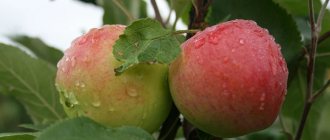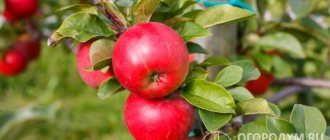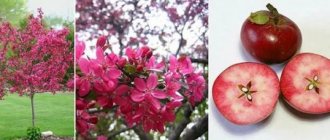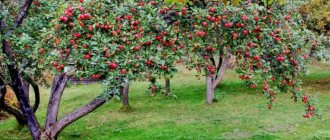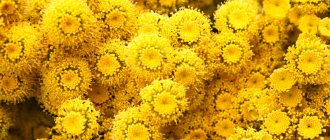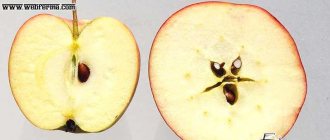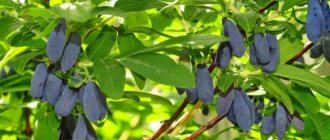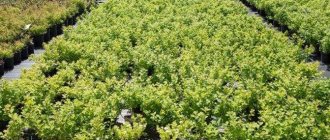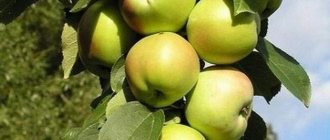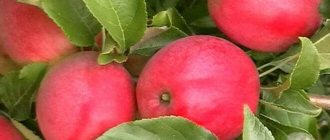What is a creeping apple tree?
This is a tree (slate), the crown of which has a creeping, squat shape. Its branches do not grow upward. The main distinguishing feature of shale is its flexible, elastic trunk .
There are good varieties of apple trees with a natural creeping crown. Some of them:
Melba is a Canadian variety of apple tree . The ripening period is summer, with the fruits fully ripening in August. They are medium in size, weighing up to 100 grams. Shade – white with red. Shelf life is about one month.
The apple tree has an average yield rate. It begins to bear fruit after 3–4 years. It is easy to shape, but tends to thicken and requires thinning of shoots. Affected by scab.
Borovinka is a Russian variety of apple tree . The ripening period is autumn, with full ripening of the fruits in early September.
The apples are large, the weight of one reaches 200 grams. It has a light yellow or greenish color. Shelf life 2 months.
The variety has good plasticity, high yield and resistance to scab.
Some gardeners independently form a crown along the surface of the soil, cut and bend branches to it.
To create stlanza, any variety of apple tree is used . But it is better if the tree bears large fruits, the taste of which is quite high.
To plant, you need to take a seedling that is 1 year old. Its trunk must have great flexibility.
The seedling is planted vertically along with the soil in which it grew.
Spring planting is carried out in a vertical position . After 2 - 3 weeks, the top of the seedling is shortened by 10 - 15 cm. Gently tilting the trunk towards the ground, secure it with a pin or metal hook. The distance between the soil and the bending point should be 40 cm. Such work is carried out in May and June.
The shoots that grew in the first half of summer are in an upright position. But in the period from June to early August it is necessary to secure them with wire pins in a horizontal position. They are arranged in such a way that they do not hinder each other’s development in the future.
YOU SHOULD REMEMBER ! Bending down must be done on time, to avoid stiffening. If you remove the hooks from the woody shoots, the shoots will rise vertically.
The height of an adult apple tree should be only up to 45 cm. A low-growing tree will be better covered with snow. And he is not in danger of freezing.
Thanks to the location of the branches and suitable climatic conditions, the apple tree will bear fruit earlier.
Many varieties produce their first harvest when the tree reaches two years of age.
Commercial fruiting begins at 4–5 years.
You can often find a plate-shaped (Arctic) stanza and a double-armed bent (melon) apple tree.
The double-armed stanets is a vertical bole with two horizontal conductor arms located at a distance of 10 -20 cm from the ground. They are directed in opposite directions from each other. Each must have up to four branches.
IMPORTANT! The gap between them should be 0.3 - 0.4 m. Overgrowing wood with branches fills the frame of the crown where the fruits will be placed.
To give the correct shape, special pruning is carried out.
On the stile, formed in the form of a plate , there are 3-4 humeral processes.
To create a squat crown position, the following condition must be met. It is necessary to timely transfer the growth of the tree growing upward to a horizontal position.
Formation of a two-armed slate.
An adult apple tree can have any shape created by pruning. Flat plate is the most common crown shape.
When forming the crown of a young apple tree, the size and configuration of the planting site are taken into account.
Standard
The standard tree is formed artificially. It has an even trunk without unnecessary branches and a crown in the form of a geometric figure, most often a ball. Standard trees are not tall, so they are easy to care for.
High
A standard variety with high winter hardiness. Fruits in 5-6 years. The harvest from a tree is up to 70 kg.
The fruits are round, greenish-yellow, weigh approximately 50 g. When ripe, the apples acquire a red blush. High resistance to scab. Keeps for a month.
Miasskoe
Late summer variety. The yield per tree is 30-60 kg. The crown is rounded-pyramidal. Fruiting occurs 5-6 years after grafting.
Flat-round apples are yellow in color and have a rough skin. Weight – 80-100 g. Scab resistance. The juicy pulp has an excellent sweet and sour taste. Shelf life – 1.5 months. High adaptive abilities. Dry air deteriorates the taste of apples. Miasskoe is used for breeding - standard and low-growing varieties are created with its help.
Tavatuy
A new product from the Ural selection. Autumn variety, high-yielding and winter-hardy. The tree is taller than average.
Fruit weight - 120 g. Shape - flat-round, apples are slightly ribbed. Crimson, speckled. The creamy pulp has a sweet and sour taste. The fruits are stored until January.
Growing even small apples in Siberian conditions is a difficult task. An important factor for success is the correct choice of variety. Thanks to the work of breeders, local gardeners can choose apples of different ripening periods, differing in color, taste, yield, tree height and other characteristics.
0
0
Copy link
Caring for a creeping apple tree
Slate needs some care, especially in the fall . At this time, it is necessary to insulate the crown. By pressing the branches with young shoots to the ground with special poles, they are secured with metal hooks.
Reed mats, vegetable tops, and spruce spruce branches are used to cover the crown. This will help her survive severe frosts.
To protect the root collar of a young apple tree from freezing , its trunk is covered with earth 8–10 cm in height. In winter, a protective layer of snow is added.
Otherwise, all aspects of how to care for a creeping apple tree are the same as caring for regular apple trees.
Watch the video on how to properly prepare fruit trees for winter:
Description
The creeping apple tree (also called the crabapple tree) is a dwarf tree that is shaped in a special way. In this form, it takes up quite a lot of space - much more than ordinary apple trees, but it can withstand harsh winters much better. As the name implies, such a tree is usually short-growing (up to 45-50 cm in height), its branches are directed parallel to the ground, and do not grow upward.
There are varieties of apple trees that naturally have this type of crown, for example, Melba or Borovinka. But if you wish, you can grow any variety of apple trees in the form of stanza: summer, autumn, winter, large- or small-fruited. To do this, you just need to form its crown correctly and in a timely manner, and then provide the tree with proper care.
Its low growth makes it easy to cover the tree for the winter. Thanks to this, the survival rate of plantings increases, and as a result, the overall productivity of the garden. The first fruits from Slate apple trees can be obtained already in 3-4 years, following agricultural practices.
How to save a frozen apple tree
Having noticed that the slate apple tree has suffered from severe frosts, it is necessary to take urgent measures.
A depressed state after spring blossoming, small whitish leaves due to lack of moisture are the main signs of freezing. Anti-aging pruning is a necessary measure to save a tree. And as a result, new wood will quickly grow and its functions will be restored.
According to experienced gardeners, young shoots contribute to the formation of a healthy vascular system.
Thanks to them, the entire tree will be rejuvenated and metabolism will be normalized.
Pruning is carried out in early spring. In order not to worsen the situation, it can be carried out in the last days of spring and the first days of summer. Warmth will promote rapid healing of wounds.
Dead branches are completely removed. Shortening of living branches is done with the aim of causing strong growth.
Using garden varnish, cover the cut areas. Oil paint, red lead or ocher are used to paint large saw cuts.
Attention! A damaged tree needs intensive care. It needs regular watering and feeding. Mulching the tree trunks will retain moisture in the soil.
Whitewash
In autumn, the apple tree needs thorough whitewashing of the trunk and the main branches extending from it.
To prepare the solution, use lime, clay (in small quantities), and paste for better adhesion. You can use fresh mullein for this purpose.
During whitewashing, the solution is applied to both the trunk and the skeletal branches. The close proximity of all parts of the tree to the ground cover creates an excellent habitat for diseases and pests. This could be a trunk, a standard, branches.
The procedure provides protection not only from the sun, but also from various pests . With its help you can get rid of insect eggs and pupae.
Rodent protection
To protect a creeping apple tree from rodents, different methods are used in winter:
- Adding creosote to the whitewash mixture, both as a deterrent and as a disinfectant.
- Shelter with spruce branches.
- Placing plastic bottles with poisonous bait under the trunk of an apple tree.
- Using special nets for shelter.
- Tying herbs to the branches (mint, wild rosemary, elderberry).
Using at least one of the methods, you can protect the bark and roots of the apple tree from garden pests .
Watch the video advice on how to protect an apple tree from rodents:
Weed control
During the growing season (spring and summer), the soil should be kept in a state of black steam .
By digging and loosening, it will be clean and free of weeds. Mulching is very useful. Mown grass or sawdust is spread between the rows of creeping apple trees. This helps retain moisture and improves soil microflora.
Weed control must be carried out carefully . If they grow through the crown of a tree, its vital functions will deteriorate (photosynthesis of leaves, laying and development of fruit buds).
The main processing in the form of deep digging is carried out in the fall.
Feeding the elks
To increase the efficiency of fruiting, the apple tree needs fertilizing. For the Elks, as for other species, it is the same.
The rate of fertilizer applied depends on the age of the tree and the area occupied.
The condition of the soil influences the correct choice of fertilizing.
To reduce the acidity level, fluff lime and dolomite flour are added to the soil. Using chalk, ash, or old plaster will also improve its condition.
Sawdust and peat are used to increase acidity
In the spring, fertilizers containing nitrogen are applied by root feeding. One of the fertilizers must be added to the tree trunk area: urea, ammonium nitrate, nitroammophoska, humus. They are introduced during digging.
When flowering begins , apple trees are fed with liquid solutions. Chicken droppings, slurry, a mixture of potassium sulfate and superphosphate and urea are used as fertilizer.
Dissolve the required component in water and apply it under the tree. If the weather is dry, fertilizer is applied in liquid form. When it rains, it is scattered dry.
After flowering, the creeping apple tree can be fed with a mixture of nitrophoska and sodium humanate diluted in water. You can make green manure by soaking green grass clippings in water.
Root feeding is sometimes replaced by foliar feeding. At the same time, the trees are sprayed with urea. Through the leaves, the apple tree receives the necessary elements for development.
It will not be superfluous for the garden to fertilize in the summer. It is necessary to add substances containing nitrogen, phosphorus and potassium several times every 10 to 14 days.
Autumn feeding is carried out with substances containing potassium and phosphorus. It is not recommended to apply nitrogen fertilizers; the wood may not ripen.
WORTH CONSIDERING! Minerals are especially important for apple trees before winter cold. They will increase their winter hardiness.
Growing stanza in Siberian conditions
Growing apple trees in the conditions of Siberia, where there are severe winter colds, is quite difficult. Only slate is suitable for such climatic conditions .
Its crown should be as close to the ground as possible. This will cover it with snow, which will protect it from the harsh Siberian frosts.
Insulation of the root system of the slate apple tree.
Caring for them has a number of differences. In autumn, the loose bark is removed from the trunk, whitened or wrapped in a light-colored cloth.
Particular attention should be paid to the roots. Fallen leaves, spoiled fruits and other debris under trees must be removed. To feed and insulate the roots, you need to cover the soil in the root zone with a layer of humus.
Important! The branches of the stanzas bend towards the soil and are secured with iron hooks. To protect trees from rodents, the branches that form the skeleton should be wrapped with dense synthetic fabric.
When enough snow falls, the crown of the apple tree is covered . Having covered it with snow, additionally insulate it with burlap. Compact the edges with snow to prevent rodents from getting inside.
It is not recommended to cover the tree until snow has fallen. Mice can set up a home and destroy a tree.
Slates must be insulated and prepared for winter before severe frosts occur. This will prevent them from freezing.
In this region, creeping apple trees must be provided with proper care, taking into account all natural factors.
Advice from experienced gardeners
To make caring for your dwarf garden a little easier, you can use the advice of experienced Siberian gardeners:
- In the first few years, with intensive flowering and fruit set, it is recommended to thin out the ovaries. This will take the load off the apple tree and allow it to use its strength for its own development and strengthening. If the gardener gives the tree time to get stronger, it will certainly please him with a rich harvest a little later;
- The weight of ripening apples can cause tree branches to bend to the ground. This can cause the fruit to rot or be damaged by rodents. To avoid this, you need to use supports, a trellis or cover the ground with film. The harvest is fully ripe, each apple must have a stalk. Ripe fruits are easily separated from the branch and prevent damage to next year's fruit buds;
- Slate apple trees also need fertilizer. The standard feeding schedule for straight-growing apple trees and the same concentration of fertilizers are quite suitable for them.
After reading the description and care recommendations, it may seem that growing a slate apple tree is a very complicated process. Of course, this type of tree requires a little more effort and time, but gardening in the northern regions has always been a difficult task, because there you cannot simply plant a tree and start harvesting from it. But it is the slate form of the tree that is designed to greatly facilitate the gardener’s work and help him grow a strong and abundantly fruitful garden.
Causes of creeping apple tree infertility
When buying a seedling, you should ask when it will begin to bear fruit. The early-fruiting apple tree variety begins to bear fruit 4 years after planting, and the late-fruiting variety begins to bear fruit after 8 years. Once you purchase such a tree, you will have to wait a little.
But there are a number of reasons that can affect fruiting :
- The seedling was planted incorrectly.
- The crown is incorrectly formed.
- The conditions of agricultural technology are not met.
- The variety does not correspond to the growing area.
Any of the reasons can lead to a bad result.
IMPORTANT! High quality seedlings of the appropriate variety can only be purchased from farms specializing in this profile.
The infertility of slate apple trees depends on many reasons.
Creeping apple tree: description
Creeping apple tree: photo
The creeping apple tree is a dwarf variety and is formed in a special way. Despite its small size, the area it occupies is much wider than that of ordinary apple trees, but they are much less afraid of harsh winters. The apple tree is a low-growing variety, as the name itself suggests. Its maximum height is 50 centimeters. The branches do not grow upward, but parallel to the ground.
There are creeping varieties of apple trees in which such a crown was formed solely thanks to Mother Nature. These include Borovinka or Melba. If you want, varieties belonging to any ripening period, as well as small or large-fruited, can be grown as stale varieties. To do this, you will need to form the crown on time, following some rules and properly caring for it.
Due to its low growth, the tree is easily covered during the winter cold. This significantly increases the survival rate of the plant, and therefore contributes to larger yields. The formation of the first fruits begins 3 years after planting, subject to proper care.
The varieties of creeping apple trees selected for planting as stanza can be any; those that are large in size and have a delicious taste are especially suitable. To avoid misunderstandings, you should not choose plants bred in the southern regions, as they have low resistance to cold and may die in winter. An excellent option would be varieties bred in the northern regions. If you choose rootstocks, then it is better to use local wild ones that are highly resistant to frost. If cultivation takes place by scion, then any varieties will be suitable.
To plant a creeping apple tree, seedlings of the first year of life are taken, which have a flexible trunk. It will be easier for them to adapt to new conditions and forms, they will take root faster and will not break when their formation begins. When choosing a seedling, you need to pay attention to the root system and its features. The thickness of the trunk also matters; it should exceed 1 centimeter. If you do not plan to plant it in the garden right away, then you need to use a clay mash for the root system so that it does not dry out.
Correct fit
For growing such trees, there are certain rules of agricultural technology .
Selecting a landing site
When choosing a place for a creeping apple tree, it is worth determining to what extent it is protected .
It should be on a hill and provided with good protection from the cold north wind. Cold air should flow to a place located much lower.
It is necessary that in winter the wind cannot blow snow away from the site . It will be better if it accumulates.
Slants require fertile soil. Their main roots are covered with a surface layer. Due to this, the pit can be of small depth, and its width is about 1 m.
It should also be taken into account that stlants do not like swampy places .
When is the best time to plant elfin?
Early spring is the most favorable period for planting elfin. It is necessary to choose the moment before the buds bloom on the seedlings.
In the fall, when the trees shed their leaves, you can also plant apple trees . You just need to calculate it so that there are 2 - 3 weeks left before the soil freezes.
How to plant correctly
When planting a creeping apple tree, you should take into account the characteristics of its growth. The soil must be mixed with humus and poured into the prepared hole in the form of a cone. Place the seedling at an angle of 35° - 45°. The top should face south.
IMPORTANT! The cut rootstock spike should face the surface of the soil. If its wound is higher, the seedling can be broken when tilted.
Its root collar should be positioned so that it is 5 cm below the ground level.
Features of planting creeping apple tree seedlings.
You just need to consider:
- When planted shallowly, the rootstock may sprout. It needs to be removed every year.
- When planting deeply, if the soil is heavy with a high degree of moisture, the bark may rest at the neck of the root.
Having installed the seedling correctly, spread its roots evenly along the sides of the mound, cover it with earth and compact it thoroughly. For watering, you need to take 2 buckets of water per apple tree .
Carrying out pre-planting work and preparing the planting hole is the same as for ordinary trees.
A little history
Remember how shrubs overwinter: they are bent to the ground and covered with snow. In this way, for example, raspberries are preserved in the northern regions of Russia. An ordinary tree, of course, cannot be prepared for the winter like this. In the mid-20th century, European gardeners began experimenting with dwarf trees planted at an acute angle relative to the surface of the earth.
It turned out that such agricultural technology makes it possible to preserve most of the trees in winter. But the dense crown and position of apple trees create favorable conditions for the development of diseases, including scab. In addition, caring for the tree becomes more difficult.
In 1991, Russian scientists under the leadership of M.V. Kachalkin applied a technique for growing columnar apple trees in a slate form. This culture is distinguished by the absence of lateral branches, the buds are 90% flowering, which makes cultivation using the described method promising. The first experiments yielded encouraging results: the apple trees, despite serious damage from mice, overwintered safely and produced their first harvest the following year. Subsequently, work was carried out to improve agricultural technology:
- the optimal landing angle has been selected;
- methods of protection against rodents have been developed;
- recommendations for fertilizing have been prepared;
- planting schemes have been tested.
The results of an experiment on growing columnar apple trees in the stanza culture were published in 1997. Subsequently, amateur gardeners used the method and made their own suggestions.
Reproduction
The plant can be propagated by dripping.
Since its branches are located very low, this process is not difficult to carry out. A small transverse incision is made at the point where the branch touches the ground, which slows down the outflow of nutrients. This causes swelling and small roots to form.
Having deepened the prepared branch into the ground, fix it with a wire bracket. Sprinkle some soil on top. Watering is necessary 2 times a week, depending on weather conditions.
In autumn, the mother branch can be pruned. And transplant the rooted plant to a new place.
It can be propagated by grafting if you find the right rootstock.
In autumn, when sap flow stops, an annual shoot (cutting) is cut off. It lasts until spring.
And during the period until the buds have blossomed, they vaccinate, choosing a solid branch.
It should grow away from other branches so that they do not shade it. Make a diagonal cut on the branch. The cuttings must also be cut off, leaving up to four buds.
A cut is made on the branch and on the shoot and they are matched by cuts so that their bark touches and aligned. Using film, wrap the grafting site and cover it with garden varnish.
Even a novice gardener can perform this procedure.
Autumn pruning of apple trees
Many gardeners, for a number of reasons, refuse to carry out this procedure in the spring and prune the apple tree in the autumn. The fact is that this work can be done in the spring in a strictly defined period of time, when the tree does not produce sap. Often this period is only a few weeks, and gardeners cannot always choose the time for this work. It is much easier to prune an apple tree in the fall, which is done after the leaves have fallen and the harvest has been harvested.
It is customary to distinguish three types of apple tree pruning in the fall: strong, medium and weak. Light pruning can be done on young trees, from which new shoots that have grown over the current year are removed.
Medium pruning is carried out for apple trees aged 5-7 years. The main goal of performing such a procedure is to subsequently increase fruiting rates. In this case, you need to trim the strong shoots by one third and thin out the crown itself, which will prevent thickening.
Heavy pruning is performed for apple trees aged 10 years and older. Its main purpose is to maintain fruiting at the proper level and prevent thickening of the tree. Old branches are removed, which over time can become covered with various fungal diseases.
When performing this work in the fall or spring, remember that pruning the apple tree must be carried out with a high-quality, disinfected tool. All large cuts should be treated with garden varnish, which prevents infection of the tree and its weakening due to such large cuts. This work is not particularly difficult and can be done even by a novice gardener. You just need to correctly determine which branches should be trimmed and removed.
Pruning a creeping apple tree
Pruning should begin in early spring. At this time, diseased and withered shoots are removed. Then, throughout the entire season (summer and autumn), their growth should be monitored and excess branches that lead to thickening of the crown should be trimmed.
Proper pruning of a creeping apple tree.
ATTENTION! Constantly growing tops are removed. If you do not prune them, an apple bush will grow instead of a tree.
Shoots that lead to thickening of the crown are cut into a ring.
Autumn pruning involves removing dry branches.
How to properly prune an apple tree in the fall - diagram
In order not to harm the plantings, you need to know exactly how to prune an apple tree. There is a detailed diagram for this:
- All actions are carried out with sharp and disinfected tools: pruning shears, garden hacksaw, lopper.
- The blade of the pruning shears should always be at the bottom. The emphasis is located above the shoot.
- Initially, remove all dry, diseased and broken branches. The cut is carried out to healthy wood.
- They get rid of shoots that grow upward, these are the so-called “tops”.
- Remove all growth below the first tier.
- At the next stage, all shoots that shade the crown are cut off.
- When thinning pruning, those branches that grow at a very acute angle to the trunk are also cut out - less than 45°.
- For rejuvenation, you can cut long branches (longer than 15-50 cm) by one third.
- Further actions depend on the age of the fruit tree, variety and selected crown shape.
Pruning columnar apple trees in autumn - diagram
Columnar forms are considered a special type of tree. They are easily distinguished by their strong main shoot and barely noticeable side branches. Thanks to this feature, all the vital forces of the plantings are aimed at the formation of large and juicy fruits. To achieve the desired crown shape, it is important to know how to prune apple trees in the fall; the diagram for columnar forms is as follows:
- When planting, all branching side shoots of the seedling are removed down to stumps with two buds.
- Next fall, choose the two strongest horizontal shoots. The rest are cut back to stumps with buds.
- In the third year of life, the branch that bears fruit this season is removed, and the other two young shoots are pinched.
- After 3-5 years, it is considered that the crown of a columnar apple tree is fully formed. Then only sanitary and formative pruning is done.
- Old columnar plantings are rejuvenated by cutting the trunk 70-80 cm from the ground.
Pruning dwarf apple trees in autumn
Another scheme is used for small trees. When figuring out how to properly prune a dwarf apple tree, it is important to consider the following nuances:
- When planting, the seedling is shortened by 25-30%. If its root system is weak, then at least one-third of the length is removed; if the roots are well developed, they get by with pruning a quarter of the branches.
- In a two-year-old dwarf apple tree, shoots of the first order are removed to the outer buds at a distance of 30-35 cm from the ground.
- Autumn rejuvenating pruning of dwarf apple trees is carried out when the plantings have reached the age of 5-6 years. In this case, three-year-old strong shoots are removed to viable second-order branches.
Pruning a creeping apple tree in autumn
Another non-standard variety of fruit trees are creeping forms. Many gardeners avoid them, believing that such seedlings take up a lot of space. However, the undoubted advantage of this form is that all branches are equally well illuminated by the sun, due to which the fruits are formed large and juicy. Pruning creeping apple trees in the fall for beginners only at first glance looks complicated, so you just need to follow some rules:
- First order runs should grow at a distance of 40-70 cm from the ground.
- The height of the tree should not exceed 3–3.5 m. To do this, all strong, tall shoots that stretch upward are removed.
- It is always necessary to trim the tops, otherwise you will end up with an apple tree bush.
- All branches that grow in one direction and thicken the crown are removed.
How creeping apple trees are formed
The horizontal position of the crown branches from planting and the entire fruiting period is maintained by holding them near the ground. The inclined branches are directed in opposite directions with free space.
The shoots that grow at the base of the trunk are bent in the opposite direction relative to its growth and pinned.
The horizontal position of the apple tree branches is ensured by pinning them to the ground.
When forming the crown, it is necessary to remove damaged, broken branches, as well as those that create shading. At the beginning of spring and summer, shoots that create shading are removed.
Each skeletal shoot should grow in the right direction and be provided with good lighting.
Growing shoots are turned into fruiting branches by pinching them near the fourth or fifth leaf. If they are industries, the procedure is repeated.
It will take almost 6 years to form the correct crown of a creeping apple tree .
This is not a difficult job, but it must be done every year.
The slate seedling can be planted in a straight position, without tilting. In early spring it should be pruned at a height of 12 -15 cm.
When the buds sprout shoots 20 cm long , you need to direct them to the sides. Pressing it to the soil, pin it with metal hooks, leaving a gap of up to 8 cm between them.
Further actions are carried out in the same way as when forming seedlings planted at an angle.
Important! In the fall, the stlantsy, formed using different methods, bend down for the winter.
Unusual varieties of apple trees
There are also varieties that naturally grow horizontally. Thus, in the Urals in the recent past, Nikolai Mazunin dealt with this problem, who managed to develop the Sokolovskoye and Podsnezhnik varieties based on the experiments of Sergei Isaev. They do not grow higher than 2.5 m on a seed rootstock and 1.5 m on a clonal rootstock. When forming a standard-free crown, they behave like dwarf trees. (Elfin trees or elfin forms are called prostrate shrubs and trees creeping along the ground.) These varieties of apple trees are not very common due to their low yields, but they could take their rightful place in ornamental gardening.
Back in the 19th century, during the intensive development of Siberia, gardeners wanted to see apple orchards in this harsh region. After unsuccessful attempts to grow popular varieties in the usual form, apple trees began to be formed horizontally and received a crown pressed to the ground, which was covered with snow for the winter. This method made it possible to save trees from destructive winter frosts and spring burns and obtain high yields.
Advantages of horizontal formation of apple trees
- Low-growing trees have more time to prepare for winter. Summer “lengthens” due to the autumn months, since even with cooling, the air temperature in the ground layer is higher due to the warmth of the soil and significantly less windiness.
- The first apples can be tasted 3–4 years after planting. Moreover, in the harsh conditions of the North, Siberia and the Far East, many varieties of large-fruited apple trees bred for central Russia can be used.
- In summer, the entire surface of the crown is covered with foliage so densely that there are practically no weeds in the tree trunk circle.
Disadvantages of horizontal formation of apple trees
- Often the beginning of winter is snowless, and an unprotected tree becomes vulnerable to severe frosts. To prevent this from happening, the plant is covered with boxes - when the tree is short, this is not difficult.
- The trunk and skeletal branches must be protected from mice. To do this, they are wrapped with lutrasil and nylon. The current year's young growths that form after pruning will need to be covered annually.
Arctic way of forming apple trees
There are two most common methods for forming a creeping crown. Vladimir Krutovsky is considered the author of the Arctic , or Minusinsk , method, which was developed on the basis of the melon method invented by Omsk breeder Alexander Kizyurin . The latter consists of simply bending the stem to the ground and pinching the shoots to stimulate branching. With the arctic method, they not only bend the central conductor, but also form skeletal branches, like those of ordinary, upright trees, with the only difference being that the central conductor (top of the head) becomes one of these branches. Two equal arms are formed, located diametrically opposite to each other relative to the trunk at a height of 15–20 cm. 4–5 skeletal branches are formed on each arm. Pruning stimulates the growth of fruiting branches that fill the space between the skeletal branches.
